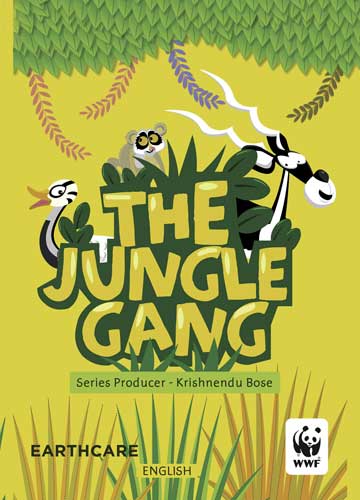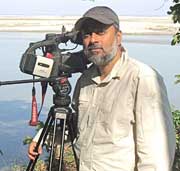
 WWF-India, the conservation organisation, in association with Earthcare Films is out with the latest films in the Jungle Gang Series. The Tamil version of the Jungle Gang series was launched by WWF-India at Ganesh Matriculation School in Velachery on 28th June and has released the English version at Welham Boys School in Dehradun today, the 24th July ‘12. This will soon be followed by the release of the Hindi and Assamese versions in Bhopal and Guwahati respectively. Jungle Gang is a fusion of CGI and live action wildlife footage shot in some of the most iconic National Parks of India.
WWF-India, the conservation organisation, in association with Earthcare Films is out with the latest films in the Jungle Gang Series. The Tamil version of the Jungle Gang series was launched by WWF-India at Ganesh Matriculation School in Velachery on 28th June and has released the English version at Welham Boys School in Dehradun today, the 24th July ‘12. This will soon be followed by the release of the Hindi and Assamese versions in Bhopal and Guwahati respectively. Jungle Gang is a fusion of CGI and live action wildlife footage shot in some of the most iconic National Parks of India.
The first film of this series was made on the Indian rhino in 2009. Upon receiving a huge response, three more films on the tiger, sloth bear and elephant were made in 2011.Till date, four films of duration 15 minutes each have been made.
The Jungle Gang is the first Indian wildlife film series that has been made exclusively for children and young adults. The series has been created by Earthcare Films of Krishnendu Bose and financially supported by WWF-India.
Speaking on the Jungle Gang Series, Anil Cherukupalli, Senior Communications Officer, Species & Landscapes, WWF-India, said, “WWF-India has been working to protect India’s wildlife for the past four decades. Among the many wild animals that WWF-India works to protect the rhino, tiger and elephant are priority species and the main focus of conservation efforts of WWF-India. The sloth bear is also present in the same landscapes as the tiger and elephant and is benefitted by the conservation efforts of WWF-India. It was thought that WWF-India’s work and its impact on conservation needs effective communication, especially among children. The mission of the film series is to expose them to the diverse wild flora and fauna of India and encourage them to actively participate in wildlife conservation
The film series has three recurring animated animal characters – Bo- the Bar Headed Goose, Kuttu- the Slender Loris and Bhoora- the Blackbuck. Bo is portrayed as a Ms. Know-it-all, Kuttu as a witty joker and Bhooraas a wide-eyed kid and foodie.
These three friends bring the flavor of three different habitats of India. They travel together to different parts of the country and seek out the threatened animals to tell their stories about their habitats, threats and conservations efforts, which have saved them from extinction. Along their journey, these friends have adventures and play pranks on each other and happen to meet the Indian one horned rhino, the tiger, the elephant and the sloth bear.
Jungle Gang is directed by Krishnendu Bose, founder of Earthcare Films.

Elaborating more on the idea of Jungle Gang, Krishnendu Bose, shared, “We conceptualized the idea of making the first children’s series on wildlife and took it to WWF-India who readily agreed to support it. The films had a new treatment so that it could appeal to the children. The series was designed using live wildlife visuals with animation. The Jungle Gang series is simple and easy to understand. At the same time it is very interesting, humorous, informative and very engaging. It talks directly to children in the age bracket of 8-14 years. The films use everyday words and phrases used by young people. In the English versions, Hindi words are also used which young people use in their casual conversations. The emotional pitch of the films is kept at a level which children and young adults can identify with. The animation in the latest version of Jungle Gang been significantly upgraded”
The overall production of this series took around 4 years. The biggest challenge & hurdle for Earthcare Films was to shoot wildlife. The films had to be shot with innovative technology and under tight shooting schedules so that funds could be used judiciously and with best results. Canon 7D cameras were used with 1200 mm lens to shoot the series. The first film on the rhino was comparatively easy to research and shoot as Kaziranga National Park is home to over 90% of Assam’s rhinos but it was difficult for the team to shoot bears and tigers as they are very difficult to spot. The team researched the seasons, locations and behavior of animals. Also, wildlife researchers, scientists, forest guards, and villagers living around reserves and published accounts and scientific journals on Indian wildlife were a strong support to the team.
2D Animation was used to set the look of Jungle Gang. Priya Kurien has taken care of the entire animation of this series and Sushmit Sen of Indian Ocean Band composed the music for it. Deepa Roy as Bo, Pallavi as Kuttu and Surjan Singh as Bhoora have done the voice over for the latest versions whereas the first film on rhino had voice overs of kids aged between 10-12 years with Isha Sinha as Kuttu, Ananta Gaur as Bo and Jai Khajuria as Bhoora
Speaking more on the challenges, Krishnendu, stated, “The greatest challenge to make this series was availability of enough wildlife footage to edit the film. Usually to make wildlife film of 52 minutes, BBC or National Geography would shoot for about 220-250 in the habitat of the animal. We had resources to shoot for only 15 days for our 15 minute films. Also, most Indian wildlife reserves actively discourage the presence of ‘outsiders’ especially with cameras in the reserves. They have very steep fees which only the BBC or National Geographic can match. They could charge up to Rs. 40,000 a day to track animals on elephant back, which may be necessary to follow tigers. To circumvent this the story telling and the editing of the films would have to be that much more engaging to seamlessly narrate the story with the message, so that the lack of mind boggling wildlife images or sequences did not impede the interest or the engagement of the children.”
Commenting on the marketing and promotion strategies for the Jungle Gang series, Anil informed, “The Jungle Gang film series release events in 4 cities across India and the resultant press coverage will act as the first line of marketing, letting the wider public know that such films are available. Later, the films will also be screened at various awareness events that WWF-India regularly conducts through its various state and field offices across India. The films will also be stocked in WWF-India’s Nature Shop. Efforts are also being made to reach out to external media partners and multiplex chains so that the films can find a large audience. There are discussions on with some media companies to distribute the films across national and international TV channels.
